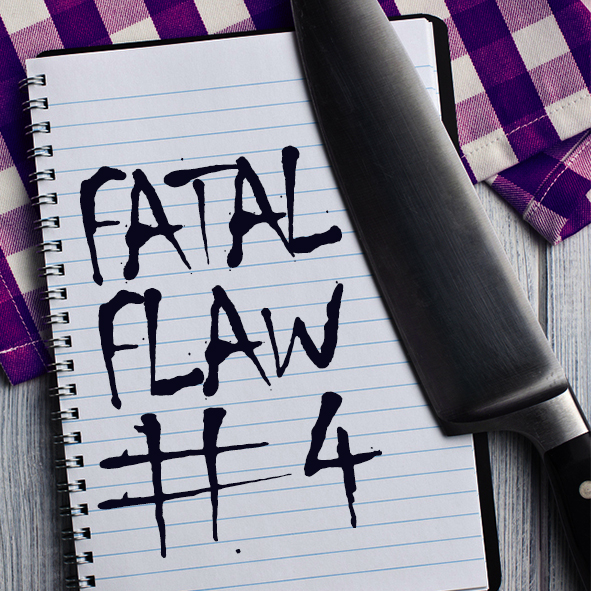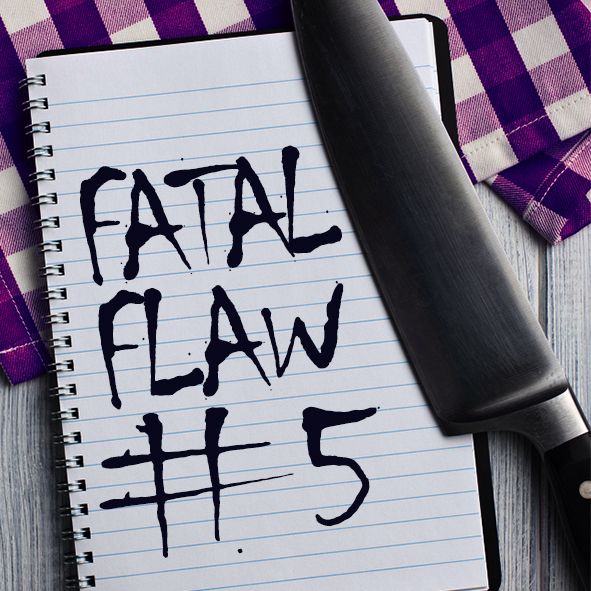Backstory in Action
This week editor Robin Patchen tackles Fatal Flaw #4—Too Much Backstory. In this month’s posts, we’ve been looking at the pitfalls of dumping backstory into our scenes and showing ways writers might creatively introduce important information pertaining to a character’s past or necessary to understand the world of the story. If you’ve missed the first posts on this fatal flaw, read them here and here.
This month, we’ve been studying how to weave backstory into your novels. You’ve learned not to stick a bunch of backstory in your dialog, and you’ve learned to start your stories in medias res—in the middle of things. Today we’re going to tackle the subject of backstory in action scenes.
When you start your story in the middle of the action, you need to give your reader a bit of information about who your characters are. The key is to slip that information into the scene in a way that feels organic. When your scene has high action, sometimes that can be even more difficult.
Hold that thought, Mr. Prowler—we’ve got some backstory to cover.
Many writers fight the temptation to tell the reader everything they think they need to know up front. They figure the more readers know about a character, the more that character will resonate. But all that backstory just slows the action down. Tell the reader just enough for the scene to make sense. You can fill in the blanks later.
Before:
I pulled my gun from its holster and disengaged the safety as I ran across the yard to the barn. Whoever was in there had left the door slightly open, and I could hear banging coming from inside. The prowler was in there right now.
He wouldn’t get away this time.
I peeked through that narrow space. It was dark, but the scent of old furniture and stale hay reminded me of Reagan McAdams, the granddaughter of the woman who’d lived on this property since she’d inherited the house from her parents a couple of generations before. Reagan was my closest friend from the time we were in diapers. Our mothers were best friends, so we saw each other all the time. We went to elementary school together, then middle school and high school. When we were fifteen, I kissed her, and we were together until she left for college. After a misunderstanding caused by our mutual friend Suzy, who’d told Rae that she and I had kissed, Rae left for college and never came back. I hadn’t seen her since.
After I returned from my tour in Afghanistan, where I served as an MP, and then my years on the Boston Police Department, Reagan’s grandmother, Dorothy McAdams, and I became close. Dorothy died two weeks ago, but before her death, she reported a few instances of prowlers. Peeking inside the barn, I thought the prowlers must be back. Dorothy had lived here alone, and Rae was her only heir. And Rae hadn’t even come home for the funeral.
I stepped into the barn, my heart thumping. I had to be silent if I wanted to catch him. The barn was dark, the only light coming from a flashlight beam I saw bouncing around in the far corner. The space was filled with furniture and old junk. I stepped around a chest of drawers and nearly bumped into a long buffet table. It used to be in the dining room, but Reagan’s mother had scratched it once when she’d been in one of her manic moods, before she’d kidnapped the baby and been sent to prison. Reagan still blamed herself for that, but what else could she do when her mother brought home a baby that wasn’t hers? Reagan had only been eleven at the time. She couldn’t have known her mother would die behind bars.
I wondered what the prowler was looking for. Dorothy had told me there was nothing valuable hidden on the property. Just all this old junk. The prowler hadn’t stolen anything, as far as Dorothy could tell.
I rounded the corner and saw a woman standing behind a desk. I aimed my gun. “Put your hands where I can see them, and turn around slowly.”
The main lights blinked on. Then she turned around.
It was Reagan.
Action at the Speed of Glaciers
That was supposed to be an action scene, but did you feel your heart pumping? Your adrenaline kicking in? Me neither. All that backstory slowed the action down.
No police officer is creeping into a dark barn in the middle of the night, gun at the ready, thinking about the historical details of an ex-girlfriend’s life. He might think about that ex—it was her home, after all. But at that moment, he would be focused on two things—catching the prowlers and staying safe. Let’s see what that would look like.
After:
I inched my way inside the barn. I’d been in here enough over the years to know only a fool would rush through this place in the dark without a flashlight.
Something banged. Nobody who had the nerve to break into Dorothy’s place would get away with it on my watch. Dorothy had done too much for me over the years. The house would belong to Rae now, not that she’d want it. She hadn’t even made it home for the funeral. But for Dorothy, I’d take good care of this property.
The sound of shuffling, muttering, and then a loud “Ouch.” I felt my way past an old wardrobe and peeked around the last corner. One person. A slight form. Probably a woman. Alone. I had her cornered.
I lifted my pistol and pointed. “Police. Put your hands—”
The person startled, and the overhead lights flickered on. I squinted and aimed my weapon. “Stop. Hands in the air.”
Her hands jolted away from what I thought was the barn’s fuse box. The woman turned and zeroed in on me. Hands in the air, she tilted her head to the side. “Brady?”
I blinked twice. The voice came straight out of the past. I hadn’t seen that face in twelve years.
“Are you going to shoot me,” she said, “or can I put my hands down?”
I pointed my pistol at the floor and engaged the safety without taking my eyes off of her.
Reagan McAdams looked even better than she had in high school.
The second selection clues us in on just a few details about this police offer and the woman in the barn. They used to know each other, they went to high school together, and she’s been gone a long time. We also know he cared about her grandmother, who has recently died, enough to enter a dark barn with his gun raised in order to catch a prowler. It’s not all the information we had in the Before section. It’s just enough. We have an entire novel’s worth of pages to fill in the rest of those blanks.
When you’re writing your scenes and you need to add some backstory, don’t try to fit in as much as you can. Instead, slide in as little as you can and still have the scene make sense. Try to make the backstory you do add organic—things this point of view character would think at this time and in this situation. Trust your readers to be patient and learn the rest in due time.
Your turn:
What bits of backstory bothers you in action scenes? How much do you want to know in order to follow and enjoy the scene?










I hate books that use prologues to give me ALL THE BACKSTORY up to the beginning of the story. If it’s important enough to tell me, start the story then. Or weave it in slowly rather than dumping pages of dry history at the front.
I agree entirely, Joe. I don’t love prologues, but if you’re going to use one, have it raise more questions than it answers. If it’s just a backstory dump, then what’s the point?
Exactly!
I think opening action scenes (e.g., battles, murders, etc.) are way too popular with relatively new writers. Seems to me (and to many agents) that the writer either puts too much backstory or not enough or not enough in the right way. Ideally, in my opinion, the backstory should reveal character, i.e., the backstory should do double duty, not just reveal facts.
As a reader, I’m not going to care as much about the outcome of the scene unless I care about at least one of the characters, usually the character with the most at stake in the scene.
Even in historical fiction, say about a battle we all know about from our history classes, I still like to care about the POV character.
I think you’re right. We need to know and care about the character first. The segment above doesn’t start the story or even the scene in my book. First, we see the character in his real life, get to know him a little, and then we jump in here. We wouldn’t want the backstory before this, either. Truth is, we can reveal all the details later.
Robin,
Thanks for the reminder and clear examples of how to include important hints of backstory in a dialogue without interfering with its forward movement and tension. How do you feel about longer interruptions in the arc of a story when the POV character is alone in a state of reflection over what is going on? I sometimes do this and think of it as an opportunity to give the backstory a bigger role in moving the story forward. For instance, at the start of a chapter I will have Rachel reading on her bed at night, worrying about whether her mother will discover what she and her twin brother are doing. She will close her book and ruminate on her worries for a short time before he sympathetic father comes in. If the tension of the story is reflected in her rumination, it can move the story forward even as the reader learns more from backstory than can be hinted at during a real time conversation.
I’d really like to know how you think this should be treated.
Thanks for the great post.
Jim Steinberg
I’m not crazy about ruminating scenes, either, Jim, especially toward the beginning of a novel. Your character might need to reflect, but it needs to be organic. If the character is reading, whatever she’s reading had better be the impetus for her thoughts. If you can work tension into those memories, it can work. But it has to be done very skillfully. Personally, I prefer backstory sprinkled in like salt–just a touch here and there, or it’ll overpower.
Writers often believe the reader needs to know everything to understand, but really, readers need just enough. Giving the reader questions without answers compels him to turn the page.
Thank you, Robin. This will help me question the length of some of the backstory segments in my current novel project. In my previous novel, “Boundaries,” I have some rather lengthy backstory reflections that have worked for some readers, but now I wonder what I’ll think when I take a look at them again. And similarly for my short stories. But you are very persuasive, and others in my writing group have commented similarly. It’s time for me to be careful!
Jim
It is wise to be careful with backstory.
You wrote: “I wonder what I’ll think when I take a look at them again.”
When I go back and read something I wrote even just a year or so ago ago, I’m often amazed at how many issues I see. Segments that I thought werebrilliant when I wrote them now I find are so-so or worse–terrible! I like to think I’m being too hard on myself, and I probably am. (That’s why, once a book is published, I never read it again. I’d probably be too embarrassed to show my face in public again.)
So don’t be too hard on yourself, even if you don’t like those sections. We’re never as brilliant or terrible as we sometimes think. 🙂
Hi Robin. I am writing my first novel and it is a supernatural mystery. My MC is trying to solve her parents murder from 30 years ago, when she was only 7 years old. The majority of the story will be backstory. How do you suggest that I handle this? Should I toggle each chapter (or sections) with the year with a different MC? I want to avoid hopping around too much so I don’t confuse the reader. What would be the best way to go with this so I don’t create an information dump? Thanks so much for your help! 🙂
Hi Rebecca,
Seems rather than backstory what you have is two stories you’re telling simultaneously. Have you ever read Susan Meissner? A lot of authors do this, but Susan’s stories are the only ones I can think of off the top of my head (and they’re excellent). Her novels often (maybe always, though I haven’t read them all) have a modern story and one from the past, and they’re intertwined. They’re not murder mysteries like yours, but the idea is the same. The Shape of Mercy weaves the story in, whereas The Sound Among the Trees has a big chunk of another story in the middle. So there are different ways to do it. I’d try reading Susan’s books or another author’s who does the same thing to see how they do it.
Be careful with too many POVs, because that can get confusing for the reader.
Put the time stamps on there, but also use clues to truly ground the reader. In current times, maybe she’s often checking her iPhone, but in the other segments, they play with the cords connecting their phones to the wall. (Remember those?) Today they’re driving Hyundais, and back then, they were driving…what? Datsuns? Those have been gone awhile. So don’t rely on that time stamp alone to ground the reader–they’ll need more than that to know where they are in time.
The most important thing is to make sure that each story is a solid story in and of itself. So each POV character in each timeline has a goal, motivation, and conflict–both internal and external. Each character is unique, has flaws and talents. Each setting needs to be rich in detail. Each scene in each timeline must have lots of conflict and tension. What you’re doing is creating two stories in one. Every time you leave one story, you want the reader to be frustrated they don’t get to know what happens next, and then immediately drawn into the other story. It’s not easy, but then what about writing novels is?
I hope that helps.
Hi, Robin,
I was very impressed with the way you ‘sprinkled’ in the backstory in the second iteration of your example. Getting backstory right is an art for sure. I am guilty of two instances of backstory dumping early on in my first novel and yes, laziness is likely the reason for not trying harder to get rid of the last two hold outs of backstory chunks. I will review and see if there is some other way of tying in this info rather than reflection. (While one passage is written as dialogue, one of the other posts warns about cleaver weaving of backstory even into dialogue). I think I need to stop using the excuse that as the people involved in the backstory are dead, they can’t play an active roll in the verbalizing of crucial information.
Thanks for your post.
Thanks!
My first drafts always have a lot of backstory. I rewrite and cut in the second draft, and then my critique partners usually make me cut more. Like everyone else, I want the reader to know everything I know about my characters. But they don’t need to know everything, and a lot of stuff, they’ll figure out just through the context. It’s an art, like you say. Good luck with your edits, and thanks for stopping by.
Buongiorno, Robin, and congratulations.
As a reader, I like to discover characters and backstory on reading, but not during the scenes. But maybe someone can write so well that I enjoy it the same!
As a writer, I like to know everything and reveal it latest than I can. In my first novel I explained in the final chapter; in others I explained by telling the whole back story from the middle of the book before the epilogue, one time in the latter words.
Sometimes it worked well.
But I haven’t strict rules and I like to write how I can feel the story in that moment.
Grazie. Thanks for he input. We all have our own unique styles. As long as it’s interesting to the reader, I think it works.
Your description of the backstory also might include two elements that help speed up the process. The internal POV and Showing instead of telling.
In the internal POV, the character is forced to reveal only the key sights and feelings at the moment of the scene. What’s in the barn? When the author uses the omniscient POV, the tendency comes to add more than the character sees immediately.
Showing actually happens more when you use your examples. In the pre-edited version, the character is telling the reader details. While some details might be unnecessary, the telling slows down the action.
Of course situations do require some way to mention memories. But even that can be changed into a way that resembles showing.
IE-A flashback –I saw Dorothy lying in her blood. Was that the noise of prowlers? Did that come from when she died, or is that sound coming in the barn?
Some thoughts to add to your excellent display of revealing information. Let me know what you think.
Excellent points, Tom, and I think you’re right. If we really put ourselves into the shoes of our POV character, we’ll limit the backstory naturally to what that character sees and thinks in that moment. I often encourage my clients to slow down during the editing process, imagine themselves in the situations they’ve written, and imagine how they would really feel and what they would really think. It’s often different than it came out on the page.
Thanks for your input. Great thoughts.